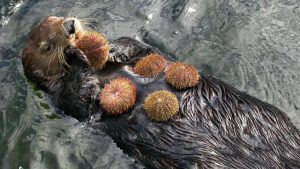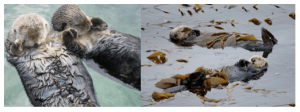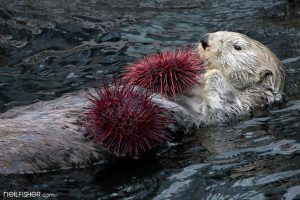Have you ever looked at a dog and thought boy that thing sure does look fluffy? Well image petting that puppy and it just feeling like a big ole fluffy pillow… so fuzzy and warm. Now take that fluffy and that warmth and multiple it by 1 MILLION!!! and you got yourself a Sea Otter.

The sea otter has the densest fur out of any mammal on the planet, exceeding upwards of 1 million hair follicles per square inch. That’s more hair per square inch than an entire German Shepard.
Not to be confused with the marine otter or the European otter, the Sea Otter is found along the west coast of North America, from Baja California all the way up to the icy waters of Alaska across the Pacific to the north of Japan. In comparison to its cousins the Sea Otter is the largest of the 3 different species. It ranges in size of approximately 4 feet 7 inches (female) to 4 feet 10 inches (males) and can weigh up to 100 lbs., probably a lot bigger than you guessed. Sea otters can also live to be about 20 years old. They have long streamline bodies that is almost entirely covered in very dense fur, the only part of its body that isn’t covers in fur are its pad. Their pads are on the bottom of their paws and the tips of their nose.
Well these little fur balls need to eat something right? A sea otter typically likes to hangout in kelp patches and rocky areas where they can dive down and pry smaller invertebrates off the rocks such as lobsters, crabs, snails, and their favorite snack, sea urchins. Once they have their tasty treat they will bring it to the surface and use their bellies as a table to hold onto the snack. Crabs, lobsters, and other inverts can have really dense and hard shells which can make it challenging for the otter to get to the meat, oh wait just kidding! Sea Otters have developed the ability to utilize rocks as tools to crack into the hard shells. Each sea otter has a unique rock that they will carry with them at all times, they have a loose patch of skin on one side of their chest (preferably their left side) that they will tuck the rock into and pull out when it’s time to munch down on dinner.

After a long day of floating around and eating tasty invertebrates otters need to take a nap and catch up on some Z’s. In order to make sure that they don’t drift away in the waves a sea otter will actually wrap themselves in the kelp to tie themselves down or a group of otters might raft up together so they can stick together, typically in groups of 10 to 100, the largest every counted raft of otters was over 2000 strong, so many otters!!!
 Now that we know a little bit about these fuzzy Sea Otters, why are they so fluffy?
Now that we know a little bit about these fuzzy Sea Otters, why are they so fluffy?
Sea otters have very thick dense fur for a couple of reasons. Sea otters although they do have legs and feet with the ability to walk on land they spend a majority of their life in the ocean rarely going to shore. Being in the water almost 24/7 it can get a little chilly out there, especially for those sea otters that make the islands of Alaska their home where water temperature can drop below 50 degrees Fahrenheit. By having such thick fur it allows them to stay incredibly warm and maintaining a constant internal body temperature, this process is known as thermoregulation. Sea otters actually spend a majority of their day grooming themselves, removing knots and tangles, squeezing out water, and removing and debris or dirt.
 Sea otters are also a prime example of the importance of a keystone species, a keystone species is crucial for any ecosystem helping keep other organisms in check. Sea otters help keep the sea urchin population in check. Sea urchins are herbivorous inverts that like to go after the lower stock of kelp, in doing this it releases the kelp from its holdfast allowing to drift off into the open ocean and eventually dying. If this persists urchins can wipe out entire kelp forests which can have even more devastating effects.
Sea otters are also a prime example of the importance of a keystone species, a keystone species is crucial for any ecosystem helping keep other organisms in check. Sea otters help keep the sea urchin population in check. Sea urchins are herbivorous inverts that like to go after the lower stock of kelp, in doing this it releases the kelp from its holdfast allowing to drift off into the open ocean and eventually dying. If this persists urchins can wipe out entire kelp forests which can have even more devastating effects.


